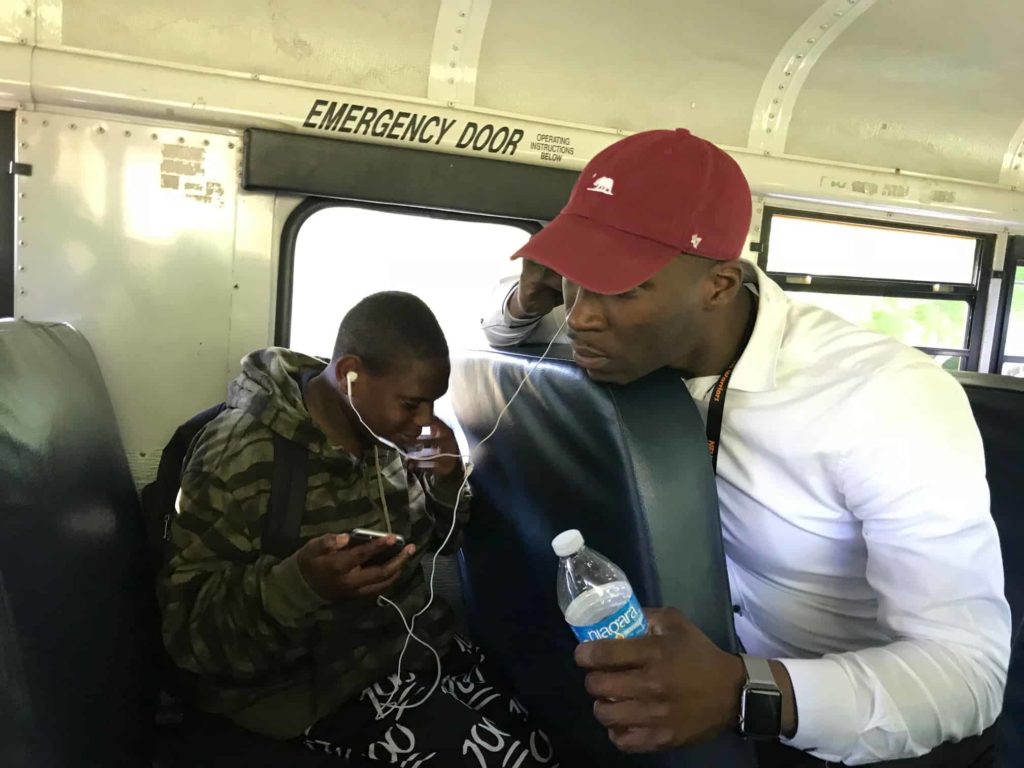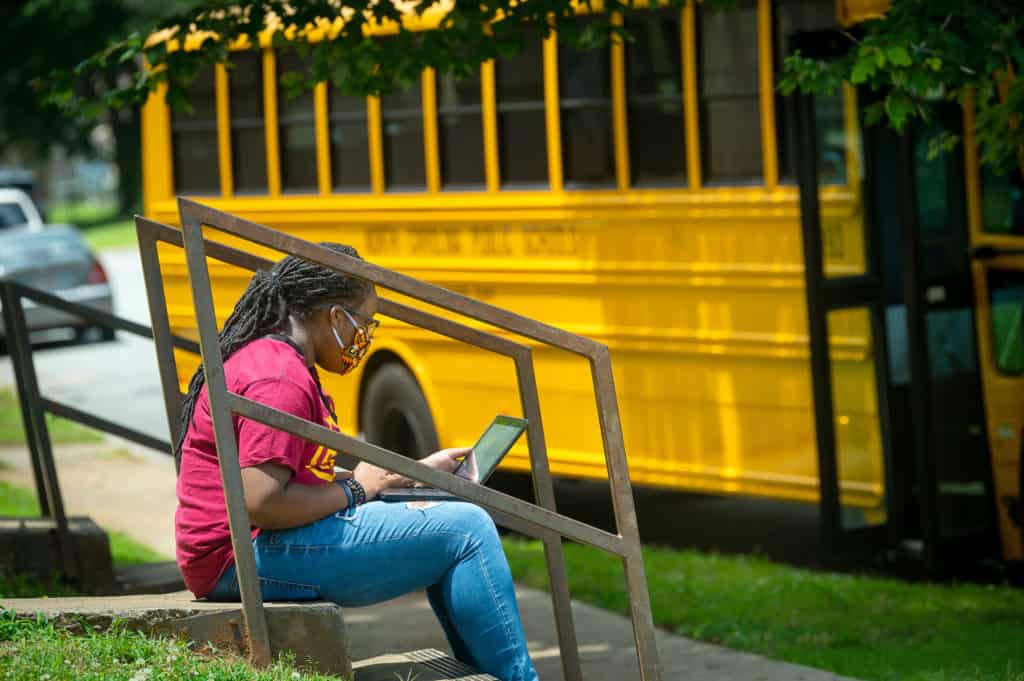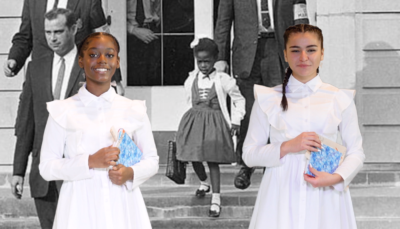|
|
On Monday morning, the corner outside my house was unusually crowded. Milling around were children, some standing with Dad, some sitting in Mom’s lap on the sidewalk, some scratching their dog’s head, some jumping up and down. Backpacks were on shoulders, masks were in hand, and there was a collective energy I hadn’t seen in what feels like a very long time. It was the first day of school, and these were the first day of school jitters.
Individually, parents and children were readying themselves to take the first steps into a new school year. And while school buildings, school staff, educators, and principals were all waiting to welcome students back, the first actual steps taken toward a new school year were up big steps and onto a big yellow bus.


When the COVID-19 pandemic disrupted the 2019-20 school year, I was struck by the absence of bus routes. School buses are woven into our daily life, their movements indicate the time of day. The experience of riding the big yellow bus can be just as varied as the individuals who climb onto it.
According to the North Carolina Department of Public Instruction (DPI), in the 2018-19 school year, 12,769 school buses operated daily, transporting 738,616 students. That year, the routes driven equated to around 169,772,337 miles — about the same as driving around Earth on the equator 6,818 times.
More than transporting students
At EducationNC, we have seen how leaders use the big yellow buses to help accomplish goals. Prior to COVID-19, we traveled in Edgecombe County with then-Principal Donnell Cannon and four teachers, riding the bus home with students to talk with parents and build community.


In Dare County, Superintendent John Farrelly told me a fire broke out this summer and the local Emergency Management System knew to call the school. Dare County Schools’ transportation director deployed school buses in the middle of the night to help get families away from the fire.
In Watauga County, a teacher started what’s known locally as “The Love Bus.” The school collects donations and then drives students around to different locations, with the goal of spreading kindness.
And when COVID-19 disrupted school and the lives of students in the spring of 2020, what then became the role of school buses? They were outfitted with hot spots and became mobile Wi-Fi units for those with unreliable internet. They were filled with meals and volunteers, delivering food to families. We watched as school staff in Gates County school unloaded buses after a three-hour route to deliver learning packets to students for remote instruction.


A Guilford County School student works on her laptop receiving internet access from a GCS Smart Bus (in background) on June 11, 2020. (Chris English / Tigermoth Creative) 

Meals are distributed from a yellow school bus in Chapel Hill-Carrboro City Schools. Courtesy of Tom Simon 

Jimmy Boone shows us learning packets. Caroline Parker/EducationNC 

Jimmy Boone, bus driver in Gates County delivers learning packets. Caroline Parker/EducationNC
In the western part of the state, you can find refurbished buses with new paint jobs — and new purposes. In Cherokee County, a bus was renovated and the construction work done by students. In Transylvania County, a bookmobile run by the Rosman High School librarian delivers books to students.


The bookmobile in Transylvania County. Courtesy of Kevin Smith 

Rosman High School librarian, Sarah Justice, outside the bookmobile. Courtesy of Kevin Smith
In Mount Airy, an old activity bus is now the Blue Bear Bus, bringing teachers to communities with books, food, and fun activities. The project was a dream of transportation director Jon Doss that started prior to the pandemic. During this difficult year, the idea resurfaced and he got the local Rotary Club on board to fund the repairs. The Blue Bear Bus hit the road in June, visiting two locations each day, for two hour stints, Monday to Thursday. Doss says, “You just wouldn’t believe what this has done for our community.”


Survey results
We wanted to learn more about the different ways school buses are being used across North Carolina. So from June to August, we ran a survey and heard from school administration, principals, superintendents, and others from 23 different districts.
To see the full report, click here.
In your district, what are buses or other school vehicles used for other than transporting students? If they are used for different reasons, tell us about them.
We had 13 comments in response to this question. Below are some examples.
During the pandemic buses were used to deliver meals and instructional materials, and to provide internet access to students. Buses were also a connection to the school when students were at home. Teachers and school staff were able to see students when they made deliveries. The school/home connection is always important to student success and even more so during the health crisis.
Buses are used at the start and end of the day, as well as transporting JROTC and other students who need to transfer between campuses each school day. Buses, minivans, and other vehicles are used to deliver free children’s meals to neighborhoods where driving to pickup locations would be a hardship. And the district often provides buses to support nonprofits in leadership or community development to build up students, staff, and community partners. Since the pandemic, internet access (Kajeet) has also been available through buses parked in strategic remote locations.
Hickory Public Schools has the HPS Book Bus which is a mobile library that takes books to children out in our community. We have 4 scheduled weekly stops at various locations out in our community. In addition to weekly stops, the Book Bus attends community and school events. The Book Bus is also equipped with a wifi router that can house over 60 users at a time.
Besides transporting students for school, after school tutoring, and summer school this past year, we also used the buses to deliver meals to the children in our community when school closed in March of 2020 till the start of the next school year when we opened for in person learning. At that point, we could no longer use the buses for food delivery because it took all of our buses to transport our students as we often had to do double runs to accommodate the one child per seat mandate. We also used our county vehicles to deliver learning packets to the students in the community without internet and without transportation to get to the school. This occurred weekly. This summer, we used our buses to go out into the community for Kindergarten registration. We have used buses in the past for Reading on the Roll, but this was the first time we used it to find and register students for Kindergarten and PreK.
Have you ever ridden on a bus for special projects for your district? Tell us about the experience.
We had six comments in response to this question. Below are some examples.
I rode buses when I first joined the district, and soon got my license and have driven for special projects as well. The local VISION leadership development program is a partnership that directly impacts the school system, and transportation is one regular support provided by the schools.
Yes – I drove one of our buses for device delivery and textbook delivery. It as rewarding to see kids that really needed these tools to do their work.
Delivery of diplomas to seniors at their home. It was a super experience. We were escorted by Sheriff Deputies and fire trucks and the students were surprised at their home. We took pictures and played loud music…really celebrated with the students.
Yes I have. When we delivered meals into the community, I rode all the different buses that went throughout the county. I did this to serve our students and help our child nutrition and transportation staff, but to also learn more about where our students were coming from in order to better understand their needs.
To learn more, you can read the full report here.





